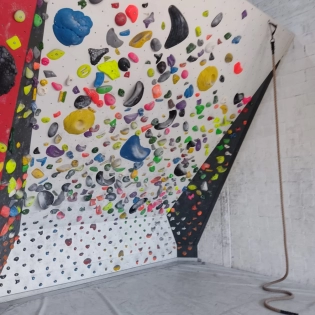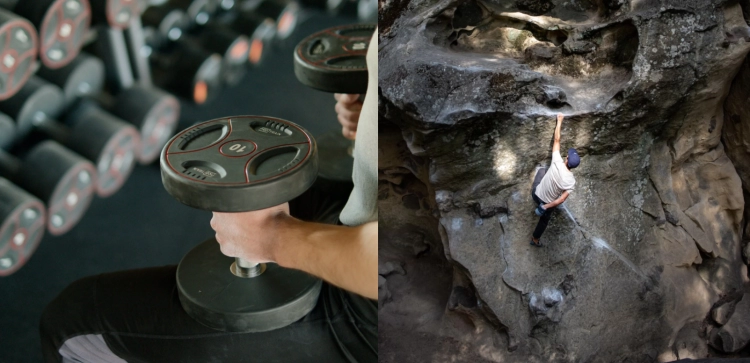How do you train to climb without a gym?
Training for climbing does not actually require a gym, you can train for climbing from almost anywhere, including your home.
Keep in mind that you should be extra careful with these exercises to not overdo it, and to not injure yourself.
1. Pull-ups
Pull-ups, as you would imagine, can be very beneficial to your climbing. Try to do pull-ups with body weight. Set a goal, and once you reach that goal, try and add more weights if available. If you do not have additional weights, try different variations of pull-ups, such as a wide grip, narrow grip, hammer grip (palms facing each other), mixed grip (once palm facing out and the other palm facing in), towel pull-ups (more about this below), and anything else that comes to mind.
2. Towel pull-ups
Towel pull-ups are a great way to train your grip and pull-ups at the same time. It also allows you to train the one arm pull-up. To do this, simply take a towel and toss it around a bar. Grab each end of the towel, and start doing pull-ups. Having 2 towels (one per hand) may be more comfortable.
To add the extra challenge of training the one arm pull-up, unbalance the towel by making one side higher and one side lower. This will cause an imbalance in the grip, which will cause one arm to pull harder than the other. Try to lower one arm as much as possible to put more weight on the pulling arm (you can do this with a band also, this will give you more room to lower your hand and to train different positions).
3. Push-ups
Though many people think that chest muscles are not needed for climbing, they actually are needed, and it is important to train them to balance your muscles out to prevent serious muscle imbalances, which could have negative effects such as poor posture.
Push-ups are a very basic and easy exercise to perform, and it's one that can be done almost anywhere. To make the exercise harder, perform different variations of, such as wide hand position, close hand position, one hand higher and one lower, adding weights to your back if available, raising your feet (you can go all the way to a hand stand with this if you are capable).
4. Dips
Another great chest and triceps exercise if you have a set of parallel bars. Just like the other exercises, if you have some weights available (or even a heavy rock or water bottle), try adding them to the exercise for extra difficulty.
5. Squats, calf raises, and sprinting
Just like with chest and triceps muscles, legs are also very important to train in order to prevent imbalances, and legs are in fact used and important in climbing.
Squats are a great way to develop leg strength and mobility. You can do it with body weight, or add additional weights if available, or do different variations of it, such as jumping high when reaching the top of the squat.
Calf raises are great for training the calf muscles, just find an edge, put your toes on it, lower your heel to the ground, and just raise yourself as high as you can from your toes, hold for a second, and lower.
Sprinting is a great all-round leg exercise that really pushes you to your limit and can show a lot of results.
6. Pinch blocks
Forearm strength and grip strength can be trained in many different ways, especially outside the gym. One of the best ways to train them is by using blocks such as a pinch block.
What this is, is simply a block, usually made of wood, with the option to attach weights to it by a rope. All you do is pinch the block, and lift it off of the ground, hold it for 7-10 seconds, and then lower it, rest, then repeat.
It really is one of the simplest forms of training grip strength that is very specific and beneficial for climbing, and one of the exercises that shows the most results.
Pinch blocks usually have multiple gripping options, such as a narrow pinch, and a wide pinch.
7. Hangboarding
Another classic, though one that comes with quite a bit of a warning from most climbers.
Hangbaords are simply boards with edges of different depths. They are usually hung above doors or in training rooms, and all you do is hang from them from your fingertips for a certain amount of seconds, depending on the training program you are following.
Adding weights to this exercise is also an option, as is training hanging from one hand.
The warning that most people give when it comes to hangboarding is to not try it unless you have been climbing for at least a year. This is because hanging from your fingers is very heavy on your tendons, which are different from muscles. They take longer to adapt and to get stronger, and they also take longer to heal from injuries. Climbing helps condition your tendons and makes them stronger and able to handle heavier loads with time. If you skip the climbing part and go straight to hangboarding, or you start hangboarding before your tendons are properly conditioned, you may be increasing your risk of finger injuries that may take many months to heal.
8. Playgrounds
Find a local playground, they usually have many different training options such as pull up bars, parallel bars, and more.
Exercises that utilize body weight are great for climbing, and playgrounds are usually full of options for body weight training, so it is a safe bet.
9. Yoga and other classes
Training doesn't have to be in the form of lifting anything, it can also be in the form of Yoga and other similar classes. If you have never done Yoga before, you may be surprised at how difficult it is, especially on the core, which is a great reason to include Yoga into your training since climbing very heavily relies on core strength.
10. Flexibility
Flexibility is considered by many as a secret gem in climbing, since many people don't think it's very important, or they know it's important, but just don't like doing it.
Being flexible gives you a wide range of additional moves on the wall. This comes into play many times, especially on the much harder routes, where finding the right beta for you is difficult. I have seen in numerous occasions how flexibility was the key attribute that allowed climbers to climb their projects. So if you don't have access to a gym for some time, training flexibility is a great use of that time, and something that should be done on a regular basis regardless of whether the gym is closed or not.
If you don't have a gym, there are still plenty of exercises that you can do that can make you a stronger climber.
Depending on where you live, your best bet may be to just find a playground, they usually have pull-up bars and other equipment that you can do some body-weight exercises.
You can do pull-ups and all of its many variations. Push-ups and all of its variations. Running, sprinting, or jogging for legs. You can also do squats and calf raises, which are great.
You can also either buy or make a hangboard and a pinch block. These are the two classic climbing exercise equipment. The pinch block would be the easier to make, or the cheaper to buy, it's really just a block of wood with a hole in the middle of it to attach a rope and weights to it. The only issue is that you need weights for this to be effective, or something heavy that you can attach to it, like a heavy rock.
Other than that, if you can get a hangboard, that will be your next best option. Hangboards are used for training your fingers by hanging from them from your fingertips. Be warned though that it is very easy to injure yourself on hangboards, and most suggest only doing it after 1 year of climbing.
I always go for body weight exercises. There are always exercises that you can do to challenge yourself and that you can find hard, like learning to do handstands and doing handstand push-ups.
I like training static and slow movements for climbing. I feel it translates the best to actual climbing.
I usually find a pull up bar and just do a lot of different grip width variations. Some narrow grip, some shoulder width, and some as wide as I can. All of them are done slowly and controlled, so I don't jerk myself up. I start from a complete dead hang position, slowly pull myself up, and even more slowly lower myself back down.
I also try to pull myself further up, so that I am in between a regular pull up and muscle up.
Training one arms is probably my favorite though, it also really requires very minimal gear, basically just a pull up bar.
Anything body weight and slow movement helps me, so pull ups, push ups, handstands, etc.





